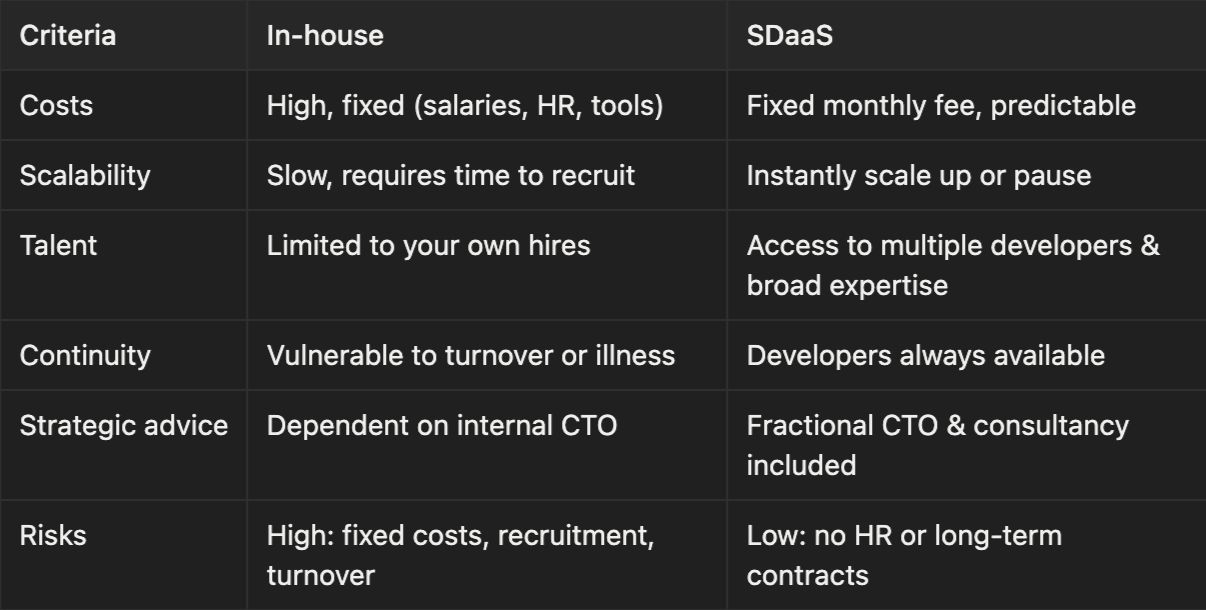
Why SDaaS is smarter than in-house dev teams

Software development is a strategic necessity. That’s why many companies face the question: should we build our own in-house development team, or choose a flexible model like SDaaS (Software Development as a Service)?
What is in-house development?
In-house development means hiring your own team of developers. You handle recruitment, select the profiles, and are responsible for salaries, training, and retention. The advantage is full control and a team that knows your organization inside and out.
But it also comes with challenges:
- A tight labor market makes good developers hard to find.
- Costs are high and largely fixed (salaries, HR, tools).
- Teams are often small and therefore vulnerable to turnover or absence.
What is SDaaS?
SDaaS stands for Software Development as a Service. You gain access to a dedicated development team and a fixed Lead Developer, all for a predictable monthly fee. Instead of dealing with recruitment and fluctuating costs, you work with predictable capacity and continuous development.
Key features of SDaaS:
- Flexible scaling up or down whenever needed.
- Ongoing results through sprints and monthly deliverables.
- Strategic advice included.
- No internal overhead or HR risks.
SDaaS vs. In-House: the comparison

What’s the best choice?
Whether you run a small business, lead a scale-up, or work in a corporate environment, the right approach depends on your situation. There’s no one-size-fits-all solution. Below are four recognizable scenarios that show when in-house makes sense and when SDaaS delivers more value.
The fast-growing scale-up
A scale-up wants to launch a new platform within three months. Hiring developers takes too long, and in-house expertise is lacking. With SDaaS, the company can start immediately and deliver new features every month.
The mid-sized company with a limited budget
An SMB wants to digitize but cannot afford a full in-house team. In-house means fixed salaries, recruitment costs, and management. With SDaaS, they get a complete team at a fixed monthly rate and predictable costs.
The corporate company that wants to keep knowledge internal
A large organization already has an IT department and wants full control. In this case, in-house may be the better option, as knowledge and security remain within the company.
The project-driven company
An organization often works with one-off projects that stagnate after delivery. Innovation stalls, bugs remain unresolved. With SDaaS, development continues, ensuring systems stay up-to-date and future-proof.
When to choose in-house?
- If software development is the absolute core of your organization (e.g. SaaS company with product as main revenue model).
- If you want complete control over processes, culture, and technical decisions.
- If you’re willing to invest in recruitment, training, and long-term retention.
When to choose SDaaS?
- If you want quick results without months of recruiting.
- If predictable costs matter more to you than fixed overhead.
- If you need flexibility: scale up during peaks, scale down in quieter periods.
- If you need not only development but also strategic advice (CTO support, process analysis, roadmaps).
In-house or SDaaS: which delivers more value?
In-house development makes sense for companies where software is their absolute core business. For many other organizations, SDaaS is a smarter, more flexible, and safer alternative. You get not just development capacity, but also strategic leadership, predictable costs, and continuous results.
Ready to scale without the hassle? Choose SDaaS and experience tangible results every month.
More blogs
View all
The future of software development
Anyone can develop software nowadays, but what truly fits your business? Discover why SDaaS is shaping the future of software development.

Marleen Scherrenberg

When to hire Freelancers and when to choose SDaaS
Unsure whether to choose freelancers or SDaaS? Compare and discover why SDaaS offers more certainty, flexibility, and strategic advantage.

Marleen Scherrenberg

When Should You Use a PoC (Proof of Concept)?
A PoC prevents surprises, provides clarity on feasibility and helps you make better decisions. But when should you use a PoC?

Marleen Scherrenberg
